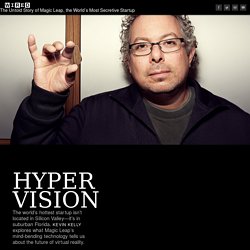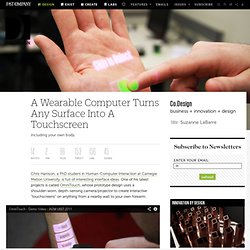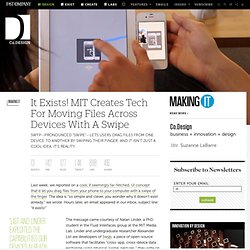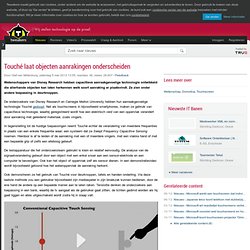

The Untold Story of Magic Leap, the World’s Most Secretive Startup. Worry about tripping over a tethering cable can seed our unconsciousness with doubt.

It might look like it’s there, but it won’t feel there. Following his hunch to exploit human biology, Abovitz set off to make an artificial-reality display in a more symbiont way. The phonelike screens used in the majority of head-mounted displays created a nagging problem: They were placed right next to your eyeballs. If the device is generating the illusion of a blue whale 100 feet away, your eyes should be focused 100 feet away.
But they’re not; they’re focused on the tiny screen an inch away. In trying out Magic Leap’s prototype, I found that it worked amazingly well close up, within arm’s reach, which was not true of many of the other mixed- and virtual-reality systems I used. Magic Leap’s competition is formidable. Abovitz realized that VR is the most advanced technology in the world where humans are still an integral part of the hardware. Peter Jackson agrees. Pranav Mistry: The thrilling potential of SixthSense technology. MaKey MaKey turns anything into a touchpad. As I discovered when reviewing the Minty Geek Electronics Lab a while back, experimenting with circuit building can be a great deal of fun.

There was one particular project in this kit that made use of the human body to complete a circuit, with a simple lie detector test being the end result. With their Makey Makey open source hardware project, Jay Silver and Eric Rosenbaum have taken such touch interaction to a much more entertaining and inventive degree. Everyday objects like bananas, coins, and even Play-Doh can be transformed into a computer keyboard key or mouse click to control onscreen gaming action, play software-based instruments or type out short messages. View all Based on research at MIT Media Lab's Lifelong Kindergarten and two years in the making, the Makey Makey printed board features six inputs on the front for attaching alligator clips.
Makey Makey has gone from first breadboard prototype through two more working units and is now entering its final production stage. Interactive projector that turns any flat surface into a touch screen wins UK design award. Light Touch transforms a projected image into a virtual 10-inch touch screen Image Gallery (8 images) Light Blue Opitcs (LBO) has won the Institution of Engineering and Technology (IET) Innovation Awards 2010 prize for Product Design with its Light Touch interactive projector. The device uses an infra-red touch sensing system that transforms a projected image into a virtual 10-inch touch screen. It allows users to interact with multimedia content and applications by touching the image, which can be projected onto any flat surface. View all LBO’s proprietary holographic laser projection technology (HLP) was first reported on by Gizmag in 2009, while still in development.
WiFi and Bluetooth connections enable wireless device-to-device communication. Light Blue Optics is a privately-funded company developing and supplying miniature projection systems for use in high volume applications in markets including automotive, digital signage and consumer electronics. Banana Phone And Pizza Box Laptop PC - Invoked Computing For Ubiquitous AR #DigInfo. A Wearable Computer Turns Any Surface Into A Touchscreen. Chris Harrison, a PhD student in Human-Computer Interaction at Carnegie Mellon University, is full of interesting interface ideas.

A Day Made of Glass... Made possible by Corning. It Exists! MIT Creates Tech For Moving Files Across Devices With A Swipe. Last week, we reported on a cool, if seemingly far-fetched, UI concept that’d let you drag files from your phone to your computer with a swipe of the finger.

The idea is “so simple and clever, you wonder why it doesn’t exist already,” we wrote. Hours later, an email appeared in our inbox, subject line: “it exists!” The message came courtesy of Natan Linder, a PhD student in the Fluid Interfaces group at the MIT Media Lab. Linder and undergraduate researcher Alexander List are developers of Swÿp, a piece of open-source software that facilitates “cross-app, cross-device data exchange using physical ‘swipe’ gestures,” they write on their website.
“Our framework allows any number of touch-sensing and collocated devices to establish file-exchange and communications with no pairing other than a physical gesture.” Why should we care? “It’s a very smart way to use existing devices without any added technology,” says Ishac Bertran, who developed the UI concept we reported on last week. Touché laat objecten aanrakingen onderscheiden. Wetenschappers van Disney Research hebben capacitieve aanraakgevoelige technologie ontwikkeld die allerhande objecten kan laten herkennen welk soort aanraking er plaatsvindt.

Ze zien onder andere toepassing in deurknoppen. De onderzoekers van Disney Research en Carnegie Mellon University hebben hun aanraakgevoelige technologie Touché gedoopt. Net als touchscreens in bijvoorbeeld smartphones, maken ze gebruik van capacitieve technologie, waarbij geregistreerd wordt hoe een elektrisch veld van een oppervlak verandert door aanraking met geleidend materiaal, zoals vingers. In tegenstelling tot de huidige toepassingen neemt Touché echter de verandering van meerdere frequenties in plaats van een enkele frequentie waar; een systeem dat ze Swept Frequency Capacitive Sensing noemen.
Hierdoor is af te leiden of de aanraking met een of meerdere vingers, met een vlakke hand of met een bepaalde grip of zelfs een elleboog gebeurt. Anand Agarawala demos BumpTop. Johnny Lee demos Wii Remote hacks.